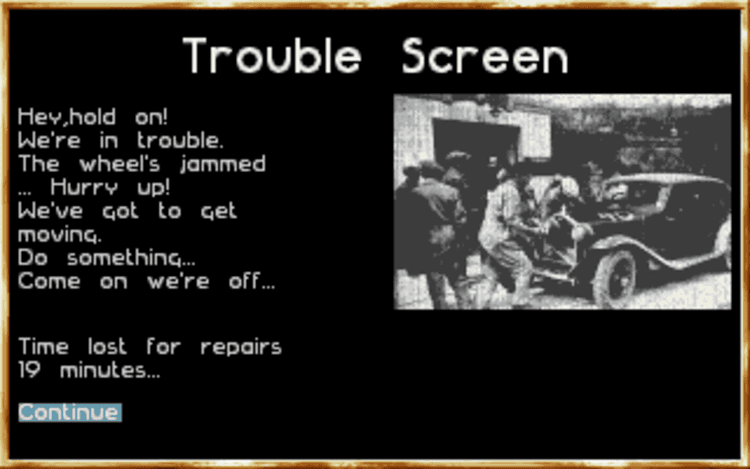
Simulmondo’s 1000 Miglia captures the romance of Italy’s storied endurance rally in a riveting DOS game that lets players slip into the leather gloves of 1930s racers. In this timeless title you jockey vintage vehicles through changing weather, repair breakdowns mid-race and manage scarce fuel, blending arcade thrills with light simulation. Fans of Indianapolis 500: The Simulation and Lotus Turbo Challenge will appreciate its balance of authenticity and accessibility. Whether you play casually or chase perfect runs, every kilometre feels rewarding, making it a must-drive classic for anyone who loves to play retro racing games online.
The early 1990s were a golden age for home computers, and Italian studio Simulmondo seized that moment with 1000 Miglia, a DOS racing game inspired by the legendary Mille Miglia open-road endurance rally first run in 1927. Instead of chasing pure arcade speed, the designers aimed to bottle the romance of pre-war motoring: leather straps hugging bonnet latches, rain-slick cobblestones echoing beneath narrow tyres, and the roar of straight-eight engines bouncing between Tuscan hills. Released when polygonal visuals were still experimental, the title relied on crisp sprite art and evocative scenery to immerse players in the sights and sounds of Europe’s most famous road race. Historical placards describe each leg, grounding the competition in real geography while the score, thick with brass stings and scratchy radio pops, conjures a festive crowd lining rural roads. That mixture of authenticity and imagination helped 1000 Miglia stand apart from contemporary circuit-based racers and ensured its reputation as a formative work in digital motorsport storytelling.
Beneath those sunshine-dappled vistas beats a surprisingly strategic engine. Races in 1000 Miglia span hundreds of kilometres, echoing the real event’s gruelling point-to-point format from Brescia to Rome and back again. That distance turns every decision into a delicate dance between daring and caution. Push the accelerator too aggressively and the temperature gauge creeps upward, threatening engine seizure miles before the next checkpoint. Feather it for too long, however, and rivals thunder by in clouds of dust. Tyre wear, fuel consumption, and even minor collisions feed into a damage-and-repair loop, so players must weigh the seconds lost during pit-lane service against the risk of mechanical catastrophe. Success comes from mastering the harmony of pace notes, weather forecasts, and split-second reflexes—qualities as relevant today as they were when grand prix stars of the 1930s carved their names into the tarmac of living history.
Although 1000 Miglia originally shipped on 3½-inch diskettes, modern enthusiasts can now play 1000 Miglia online without downloads or configuration hurdles. Browser-based emulation boots the program in seconds and preserves its original timing, letting the sprites glide at the intended frame rate on desktops, laptops, tablets, and mobile phones. Unlimited access means each player can sample the first cautious kilometres, quit, and return later at leisure, experiencing the campaign in bite-sized sessions or tackling the full thousand-mile adventure in one exhilarating push. Touch controls adapt naturally to the classic keyboard scheme, and gamepads map flawlessly, so the thrill of threading vintage cars through narrow alpine passes remains intact across every modern device. Best of all, the experience is entirely free, inviting seasoned retro fans and curious newcomers alike to taste the unmistakable flavour of motorsport’s golden era.
Many vintage racers fade once their novelty wears off, yet 1000 Miglia retains a compelling loop that survives well beyond nostalgia. Part of that resilience comes from its brisk structure: stages rarely exceed a couple of minutes, so setbacks sting but never overwhelm, encouraging the irresistible urge to attempt “just one more leg.” Meanwhile, a points system rewards not only outright speed but also smooth driving, meticulous checkpoint timing, and minimal repairs, fostering mastery without punishing experimentation. A broad roster of period-correct cars—each with distinctive handling quirks—adds further depth, as players learn which chassis conquers rutted gravel and which devours long straights. The presentation amplifies immersion with day-to-night transitions, rolling countryside, and snatches of cheering spectators that swell in stereo as the car rockets past town squares. Combined, these qualities give every run a unique texture, guaranteeing that even after dozens of completions there is always a fresh line to discover, a tighter apex to clip, or a personal best waiting to be shattered.
After three decades, 1000 Miglia stands as both interactive chronicle and enduring challenge. Simulmondo’s devotion to historical authenticity, layered vehicle management, and accessible handling ensures the game remains fresh for speed freaks and history buffs alike. Core controls mirror the simplicity of the era: arrow keys or on-screen buttons steer left and right, a single key or tap modulates throttle, another engages brakes, and a final command shifts gears upward or downward. That minimalism hides a nuanced physics model, with slip-angle drift, weight transfer, and brake fade all subtly affecting lap times. The result is a compact control scheme that newcomers learn in seconds yet one with enough subtlety to keep veterans shaving tenths from each split time long after the odometer rolls past its first virtual thousand miles.
All code used to run or emulate this title is publicly available, and 1000 Miglia remains the property of its original authors.
Share game
Share game








Share game